WHEN I STARTED DIVING, I fell in love with colorful coral reefs and marine life. If you had told me that Antarctica would someday become a favorite destination, I might have laughed and said I’d never dive in water that cold or that far away. Decades later I finally got the chance to go on what I mistakenly thought would be a once-in-a-lifetime trip. After visiting the white continent three times, I’ve caught the very real polar fever and have planned at least five more expeditions there.
It’s hard to put into words what it’s like to visit Antarctica, but thankfully I’m a photographer. Traveling there is like visiting another planet. There is something otherworldly about it, and it’s unlike any other destination. Imagine a place where there’s no people, the wildlife isn’t afraid of you, and the most stunning scenery surrounds you. That’s Antarctica.
Antarctica is the least-explored continent on the planet. With an area of more than 5.4 million square miles, it’s about twice the size of Australia and is known as the largest desert on earth, with 90 percent of the world’s ice covering the continent. The remote and harsh conditions have made polar exploration there a challenge for hundreds of years.
No one owns Antarctica, it’s not a country, and it isn’t governed as one. In 1959, 12 countries signed the Antarctic Treaty, and today 54 countries honor it. There are no permanent residents, but seven nations — Argentina, Australia, Chile, France, New Zealand, Norway, and the U.K. — have claimed parts of it. Several other countries, including the U.S., have no claimed territory but maintain permanent science research stations there.
Following in the steps of great polar explorers such as Sir Ernest Shackleton and Sir James Clark Ross, we set off for the white continent. Even with our sturdy ships and modern technology, it can still be a stressful journey. The best time to visit is between November and March. Each month offers something special, which is another reason to keep returning. During these months, temperatures can range from 20°F to 40°F on the Antarctic peninsula; so while it’s much colder inland, some areas are not as extreme as you may think.
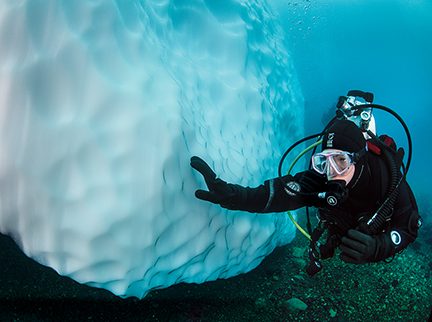
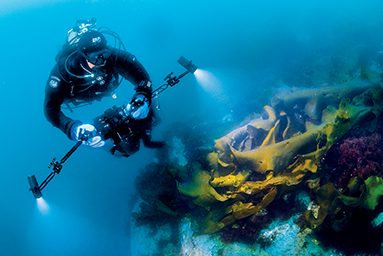
The closest route to Antarctica is boarding an expedition vessel at Ushuaia, Argentina, at the southern tip of South America and sailing across the Drake Passage to the Antarctic peninsula. There are many itineraries and routes, but crossing the Drake can be sporty. I’ve experienced both the turbulent “Drake shake” and the calmer “Drake lake” during the two-day crossings on my past three voyages. We had 30-foot seas in both directions on my first trip, but the second crossing had mere 6-foot seas, which was pleasant. On my most recent trip in early 2022, we had 25-foot seas going and about 15-foot seas returning, which wasn’t bad. The ships have good stabilizers, especially the newer vessels, so seasickness hasn’t been an issue for me. It’s still impressive to see big waves breaking over the bow and wonder how polar explorers endured these conditions 100 to 200 years ago.
Diving is restricted to about 60 feet due to the lack of support and hyperbaric chambers in this remote area. A drysuit is necessary along with warm thermal undergarments, dry gloves, and at least a 7 mm hood.
When approaching the South Shetland Islands, the seas are calm. The weather can be sunny, gray, foggy with snow, or a mix of these within an hour. As you arrive at the peninsula, you pass hundreds of icebergs where penguins stand watch as the ship moves on. You’ll also see different types of seals on the ice, and humpback and minke whale sightings occur daily. Sometimes the whales are so close that the boat has to idle as they surface and bubble-net feed right next to the ship. We watched this incredible behavior for more than an hour one day, and the vessel didn’t bother the whales at all.
Some memorable places to visit are the Lemaire Channel, Danco Island, Paradise Bay, and Neko Harbor. On many voyages you can also visit nearby Deception Island, South Georgia Island, the Falkland Islands, and even Elephant Island, which was named for its elephant-head shape and its population of elephant seals. This island is also where Shackleton and his crew famously landed after ice in the Weddell Sea crushed his ship Endurance. Incidentally, an expedition discovered the Endurance wreck in more than 10,000 feet of water in March this year. It’s an incredible discovery, and the ship is remarkably intact even after 107 years.
The islands and ice are rich with diverse wildlife. You’ll catch stunning views of massive glaciers with aqua blue and teal veins running through them, and the ice’s textures are constantly changing. When the sun is out, the ice sparkles like diamonds and the water appears Caribbean blue even though it’s icy cold. The sun can disappear, and ominous gray clouds or fog can change the entire mood and turn everything monochrome until you see what’s below the surface.
It’s common to dive a single tank with an H-valve and to have two first stages in case of a coldwater free-flow. Diving is restricted to about 60 feet due to the lack of support and hyperbaric chambers in this remote area. A drysuit is necessary along with warm thermal undergarments, dry gloves, and at least a 7 mm hood. I’ve made most of my polar trips without heated undergarments, but they are worth the investment if you get cold easily. All the diving is from rigid-hulled inflatable boats (RIBs) that usually take about six divers at a time.
This is considered expedition diving, so for safety I recommend having some coldwater dive experience along with the required minimum of 40 drysuit dives. The best thing to do before a big trip like this is to dive as much as possible in a drysuit and get used to the bulk if you’re not usually a coldwater diver. You’ll have much better dives if you are comfortable in the gear.
Expedition diving also means that you might be going places where no one else has been, so the divemaster can’t tell you a lot about the sites. You get to explore them for yourself. The sites might be walls full of green and red kelp with macro critters or whalebone graveyards from whaling in the early 1900s. Icebergs offer unique diving because they are always changing.
A divemaster with polar experience will choose the right iceberg to dive — generally one that is grounded and without large overhangs. Overhangs are dangerous because they can break off and hurt divers or cause the iceberg to flip suddenly. The best icebergs to dive have flat or rounded tops and are grounded so they can’t move. Ice is extremely dynamic, so you need to be cautious around it.
The islands and ice are rich with diverse wildlife. You’ll catch stunning views of massive glaciers with aqua blue and teal veins running through them, and the ice’s textures are constantly changing. When the sun is out, the ice sparkles like diamonds and the water appears Caribbean blue even though it’s icy cold.
As you descend the icy, white wall, it sparkles and looks translucent in the light. The surface is slick and cold with indentations from the melting, reminiscent of a giant golf ball. I enjoy running my hand along the surface and feeling the slippery ice. I think about being at the bottom of an iceberg, at the bottom of the planet, and how I never anticipated diving in a place like this. You might be the only person ever to dive that iceberg. They transform as they melt, break apart, flip, or freeze together, so you’ll likely never see the same one twice.
Ice can be a challenge to photograph. It’s bright white, and the fresh water melting slowly and mixing with the salt water creates a blurry halocline around the iceberg. The haloclines also create a buoyancy challenge. If you get your buoyancy tuned in and swim closer to the iceberg, where the fresh water is, you can feel yourself suddenly drop a few feet. This water density shift is something to be aware of while diving around ice and trying to photograph it. As icebergs melt, they also release small bubbles that can stick to a photographer’s dome port, so you need to keep wiping them off or move 7 to 10 feet away into the salt water, where you can get clearer shots.
You don’t have to be a diver to enjoy the water in Antarctica. The snorkeling is fantastic around icebergs, where you can see penguins and seals. There are several seal species: Weddell, crabeater, fur, and leopard. During my first trip, I wanted nothing more than to be in the water with leopard seals, one of Antarctica’s apex predators. We saw several lounging on icebergs, and one afternoon while walking the rocky shoreline in waist-deep water, I saw a large, dark shadow approach me. I immediately put my camera in front of it and started shooting away. I didn’t have on my mask at that moment, but I thought the animal was a leopard seal. When I reviewed the images, I saw it was a large crabeater, which was also very cool. It came right up to the camera and checked me out several times before swimming away. I left Antarctica that year knowing I had to return to see a leopard seal underwater.
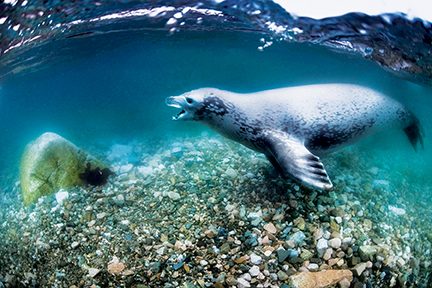
A crabeater seal approaches in shallow waist-deep water near shore. They don’t actually eat crabs but rather feed on krill that they filter through their unique lobed teeth.
Persistence pays off: On my past two visits I’ve had amazing encounters with leopard seals for more than an hour in the water each time. The first encounter was near the end of the trip in 2020. We were diving an iceberg, but I came up early because of a small drysuit leak. The rest of the divers with me came up within 10 minutes, and by the time we were on the RIB, we heard on the radio that the snorkeling group was in the water with a leopard seal. I quickly deployed my snorkel from my pocket (a foldable snorkel is a great investment for an Antarctica trip) and put on my fins while we motored over to where the snorkelers were. The water was full of brash ice — beach-ball-sized chunks — so I gently slipped in and awkwardly kicked around, thinking I’d get only one or two passes from the seal if I were lucky. I had no idea we’d be in the water with it for almost 90 minutes.
When it first zipped by me, I could see it checking me out and probably wondering about this awkward animal. The seal was about 7 feet long, very sleek, and serpentine-like. It was hard for me to twist and turn to keep an eye on it as it moved quickly through the water. Ice would hit me in the head, and I’d kick ice, thinking I accidentally kicked another diver. It wasn’t graceful, yet it was one of the top three underwater experiences of my life.
The seal came nose-to-nose with my dome — so close I could see the hair on its snout and whiskers. I positioned myself away from other snorkelers and near an iceberg, hoping the seal would swim in front of the shot I set up. It finally came right toward me with a sinister grin, and I got the shot I wanted. Mother Nature was good to us that day: — The sea of bergy bits of ice was incredible, the water was clear, and conditions couldn’t have been better.
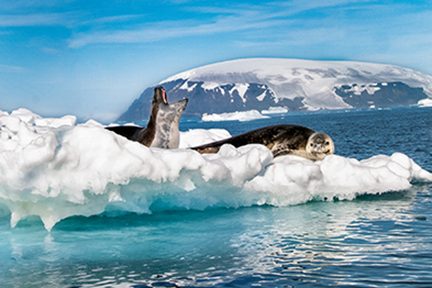
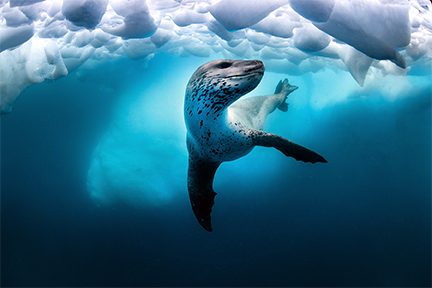
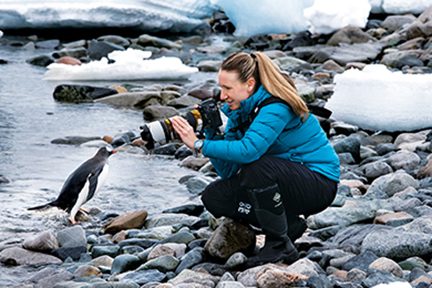
I didn’t think I could have another experience like that, but I did. A few months ago, on our first day of diving, we saw a leopard seal resting on an iceberg. We wanted to pass by to see it on our way to dive, but as we slowed down, we saw another seal zipping around underwater. When the divemaster asked if we’d like to get in the water with it, I was already pulling out my snorkel and ready to go. This seal was larger than the first one and zoomed around us, closely investigating everyone. I’m amazed it stayed with us so long and didn’t swim away.
We respectfully let it come to us and tried not to corner or surround it. Leopard seals have a mouth full of teeth and can open their jaw almost 180 degrees. They are hunters and eat other seals, penguins, sharks, and squid. They can be dangerous to humans, and many RIB drivers will tell horror stories of a leopard seal puncturing their tubes and biting at the boat. You should treat them, like any wild animal, with caution and respect. There is nothing better as a photographer than being able to document and capture the unique behaviors of an animal that’s mysterious and possibly misunderstood. I’ll never forget either experience.
You’ll also see — and smell — millions of penguins. Yes, you can smell them before you see the colonies. Only emperor and Adélie penguins live on the continent, but others breed on the peninsula. You can see gentoo penguins, which are the third-largest and the fastest in the water — able to swim up to 22 mph. They are very curious on land and will waddle right up, look at you, and sometimes pick at your pant zippers or investigate your camera bag. Penguins are determined little birds who build nests of stones and climb rock walls or icy cliffs to nest. The region has an estimated 20 million breeding penguin pairs. The Adélie chicks hatch in December, so you can see them grow and fledge if you visit Antarctica after that time.
It’s nice to sit on the rocks and watch penguins go by, observing their behaviors and seeing them navigate the penguin highways to and from the water. They jump on and off icebergs and zip around like torpedoes in the shallow water. They are fast and graceful in the water yet awkward on land. They’ll hop on rocks and fall on their faces, but they shake it off and keep going.
They are loud and call out to their mates and chicks. Sometimes you see penguin fights or the chicks chasing a parent for food. You’ll observe the parents feeding the chicks until they can swim. The penguins have no fear of humans on land, and it’s amazing to be around wildlife that isn’t afraid of you at all. They are very cautious if you’re snorkeling near the beach because they may mistake you for a predator leopard seal.
In addition to diving, Antarctica is about adventure and exploring topside. RIB cruising is a great way for photographers to see a lot of wildlife as well as scenic shots of icebergs and glaciers. Penguins will jump next to the boat in all directions, and there’s always a chance that a humpback whale will surface close by. As we approached a stunning, brilliant blue iceberg on one excursion, about two dozen crabeater seals surfaced and started swimming all around us, and then penguins began to jump all around. I didn’t know which way to point my camera, and my brain was overloaded with joy. With its many photo and video opportunities, Antarctica is a photographer’s heaven.
Most expedition ships also offer kayaking and camping. I’ve never camped there, but kayaking allows you to quietly move along the ice and see wildlife. Camping is a unique experience that requires advance registration. You can also take a polar plunge, but I’ll only make that icy dip with my drysuit on.
Each time I depart and watch that last iceberg disappear behind a gray veil of fog, I plan to return to this magical place. Sometimes I wonder if returning could ever be as good as the first expedition, but I’ve found that each visit is better than the last.
Antarctica inspires me, and the thought of it disappearing or changing frightens me. This remote place at the bottom of the Earth is fragile, and the Antarctic Treaty comes up for renewal in 26 years. That may sound like a long time, but the treaty was created so future generations like mine could experience Antarctica, and I want to see it safeguarded for generations to come. The best way to do that is through education and inspiration.
I used to think Antarctica was far away, but it’s not that far. It’s spectacular yet delicate. I hope you feel inspired to learn more or even visit the white continent yourself. AD
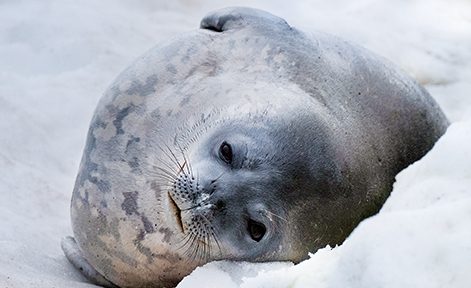
Leopard seals rest and yawn on an iceberg after feeding all morning on Adelie penguins.
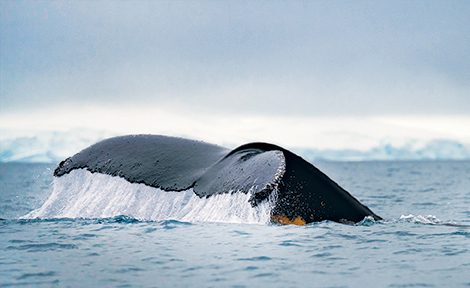
How to Dive It
Conditions: The best time to go is November through March. Air temperatures range from 20°F to 35°F, and water temperatures range from 29°F to 35°F. While there are many tour operators, experienced polar diving experts offer only a few dive trips each year. Divers must have earned a drysuit certification and logged at least 40 drysuit dives. The maximum depth for diving is 60 feet. No experience is necessary for snorkeling.
Photo tips: Keep a camera with you aboard the ship to capture wildlife opportunities, wear good shoes around the ship, and always have your coat. The more time you spend outside on deck or on an RIB, the more opportunities you have to spot wildlife or amazing scenery. Take two cameras if you’re shooting both underwater and topside so you don’t have to remove a camera from its housing. Don’t spend your trip looking through a viewfinder, however. Remember to look with your own eyes and remember it for yourself.
Explore More
See more of Becky Kagan Schott’s journey to Antarctica in these videos.
© Alert Diver — Q2 2022